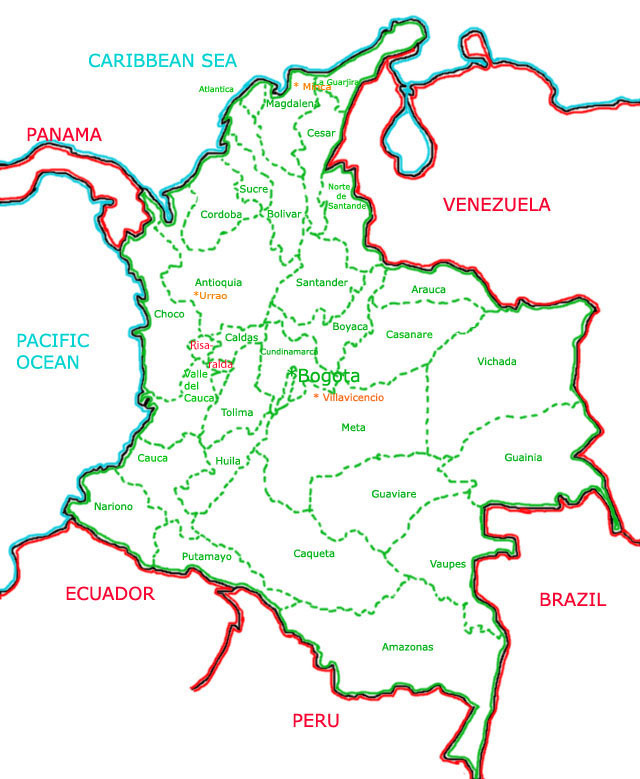Dilophonotini thumbnails
Dilophonotini:
Aleuron, Enyo, Pachygonidia, Unzela
Thumbnails: Colombia
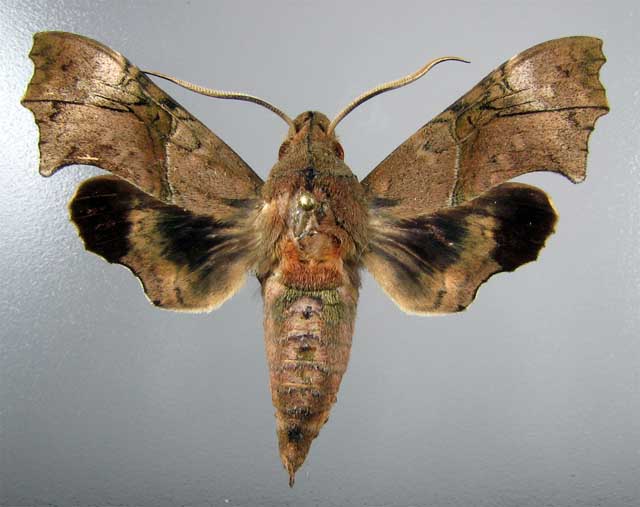
Aleuron neglectum, Villavicencio, Meta, Colombia, July 3, 2011, 500m,
Km 13 via Acacias, 04°03’55.0 N 073°41’87.0 W;
LFW = 25 mm, leg. G. Nielsen.
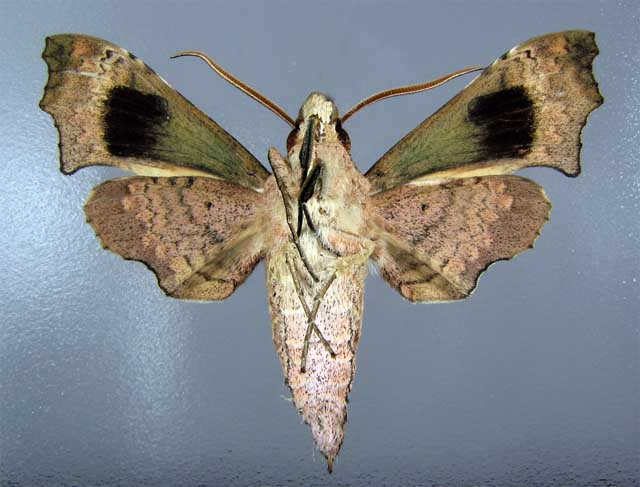
Aleuron neglectum, Villavicencio, Meta, Colombia, July 3, 2011, 500m,
Km 13 via Acacias, 04°03’55.0 N 073°41’87.0 W;
LFW = 25 mm, leg. G. Nielsen.
This tentative checklist will become more accurate as images and information are sent to me. If you would like
to assist in the development of this worldwide Sphingidae data/image
base, please send info and images to Bill Oehlke.
I have arranged the images in accordance with my perception of wing characters: predominent markings, shape, colour,
size.
There are probably some Colombian species not listed below, and there are some species not officially confirmed for Colombia, although
I think they have a good chance of being found there.
Females often have a wing shape or pattern that differs from the males. I hope some day to also have a thumbnail checklist for the females.
Gregory Nielsen has sent me many images and data from Villavicencio, Meta, Colombia, and his efforts have inspired these thumbnail checklists.
Having both recto and verso images with full data: location, elevation, date, forewing length, greatly helps with identification work.
Aleuron
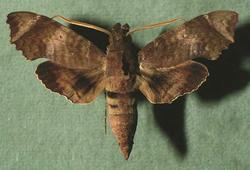
Aleuron carinata
Black belts on anterior margins of abdominal segments; usually hidden except for first two broader belts.
Fw: nine more or less evenly dentate transverse lines between base of CuA2 and outer margin.
Distinct dark slightly concave arc from costa midway between cell and apex to midpoint of outer margin;
dark region interior to arc; light region exterior to arc.
light area around small dark cell spot.
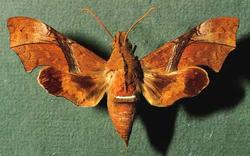
Aleuron iphis
Conspicuous abdominal white belt
Fw: Orangey-brown ground colour;
Fw: crossed medially/slightly obliquely by four narrow back lines, the basal most bordered with white basally and distally.
Brown scales between the outer three, forming a prominent wide, dark band.
|
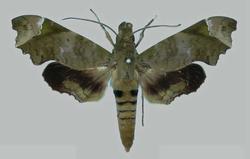
Aleuron cymographum ??
Black belts on anterior margins of abdominal segments; usually hidden except for first two broader belts.
Olive-green g.c., clayish grey shades, indistinct undulating lines in basal half.
Minute black discal spot; dark shade beginning at costal margin near apex of discal cell, ending on o. m.
between M3 and CuA1.
Indistinct lines in fw outer half, one bordered with sharply marked,
undulating white line, stops at dark oblique shade.
Fw lacks pale apical patch, delimited basally by crenulated white line between costa - M2.
M3 apex more prominent than chloroptera, inner margin more concave.
Hw: costal margin slightly convex near base, but not lobed.
Blackish median band widening distally, broadly joining blackish marginal band.
questionable in Colombia
|
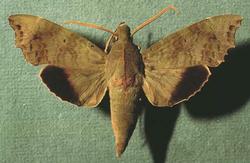
Aleuron chloroptera
No black belts around adomen
Almost uniform drab grey-green with nine, weak, more or less evenly dentate transverse lines between base of CuA2 and outer margin.
Small, darker crescents in submarginal area.
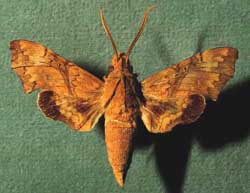
Aleuron neglectum
Similar to iphis.
Abdominal white belt much narrower than in iphis.
Fw: black median lines indistinct posteriorly, except the basal most, which is bordered white basally but not distally,
except at costal margin.
Often more greyish-brown
Villavicencio, Meta, July 3, 2011,
500m, Gregory Nielsen.
|
|
Enyo
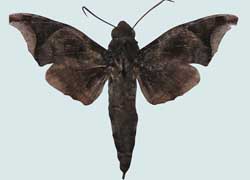
Enyo cavifer
In both sexes forewing apex truncated, not sinuate (concave) as in Enyo gorgon. Ground colour chocolate-brown, almost black in some places.
Fw discal cell narrower than in either Enyo gorgon or in Enyo taedium taedium.
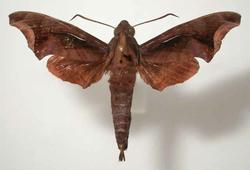
Enyo bathus
Fw similar to gorgon and taedium.
Anterior half of fw not as contrastingly pale as gorgon, but with dark brown, median, longitudinal line that
diverges apically to form dark brown triangular patch (larger than in
gorgon) before marginal pale brown half-moon shaped patch (narrower than gorgon).
|
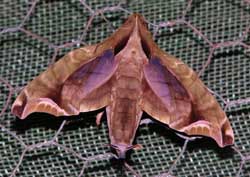
Enyo gorgon
Forewing apex produced, with concave outer edge, not straight cut as in Enyo cavifer.
Lower half of wing noticeably darker than upper half.
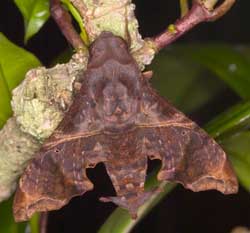
Enyo lugubris
Body, wings dark brown.
Fw: large black patch covering most of outer half of wing.
Pale
tan cell spot with small dark inner pupil,
Fairly straight median line to inside of cell spot.
|

Enyo taedium
Fw: shape, venation as in gorgon; costa not as convex; crossveins m1-m2, m2-m3 both straight, not displaced;
lower angle of discal cell obtuse, more proximal than upper angle, crossvein m2-m3 about half length of m3-cu1a; M2 curved at base.
G. c. essentially unicolorous, lacking: 1) division into paler anterior half, 2) darker posterior half,
3) triangular dark brown postmedian patch.
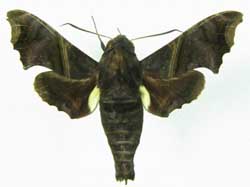
Enyo ocypete
Fw: dark area not sharply defined, prolonged along antemedian line to posterior margin.
Discal spot small.
Male hw: diagnostic pale yellowish-white anal patch.
Females similar to Enyo lugubris lugubris, but have broad brown belt across
base of abdomen (this belt either very narrow or absent in Enyo lugubris lugubris).
Villavicencio, Meta, 500m;
January 19, 2011, Gregory Nielsen.
|
|
Pachygonidia
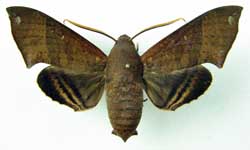
Pachygonidia caliginosa
Fw similar to subhamata, but apex pointed (not sinuate between Rs3 - Rs4, i.e. not dentate at end of Rs4).
O. m. slightly angulate at bottom of hollowed out region below apex, not as rounded (convex) as in subhamata or mielkei.
Hw: two median transverse pinkish-buff bands, similar to mielkei and subhamata.
Villavicencio, Meta, 500m;
March 4, 2011, Gregory Nielsen
August 25, 2011, Gregory Nielsen
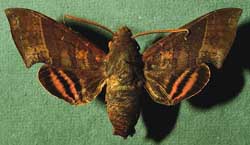
Pachygonidia drucei
Fw similar to P. hopfferi, but apex pointed, not sinuate between Rs3 - Rs4, i.e. not dentate at end of Rs4.
O.m. only slightly hollowed out between apex and M3, not angled at M2.
Discal spot relatively large, clayish patch below apex much more distinct as is diffuse, whitish scaling near anal angle, compared to hoppferi.
Hw: three median transverse rose-pinkish bands as in hopfferi.
|
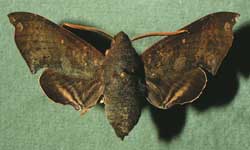
Pachygonidia subhamata
Fw apex sinuate between Rs3 - Rs4, not pointed as in caliginosa. O. m. concave between Rs4 - M2, convex at M2, not angulate.
Distinct grey-brown submarginal patch on M1-M2.
Hw: two median transverse pinkish-buff bands, similar to caliginosa and mielkei. Pink tint usually diminished, replaced by brownish shade.
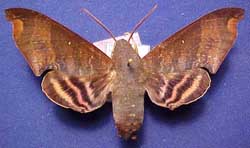
Pachygonidia martini
Fw similar to P. hopfferi but fw outer edge of martini rounded at end of M2, not angulate/pointed as in hoppferi.
Outer edge of dark postmedian band wavy or toothed, but in hoppferi very smooth, straight.
|
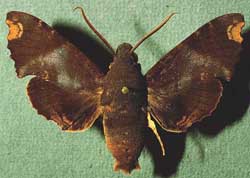
Pachygonidia ribbei
Fw: outer margin denticulate, anal angle less produced than in other Pachygonidia.
Pale orangey-brown submarginal patch on M1-M2 distinct, larger than in other Pachygonidia.
Fw median and lower postmedian areas have pale violet scales.
Hw: two short bars at anal angle.
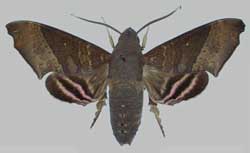
Pachygonidia hopfferi
Fw: outer edge of postmedian transverse band straight; wavy in martini.
Fw apex truncated or sinuate between Rs3 - Rs4. O.m. concave between Rs4 - M2, quite angulate at M2.
Grey-brown submarginal patch on M1-M2 indistinct.
Hw: three median transverse rose-pinkish bands, as in drucei.
Pachy. odile e??
|
|
++++++++
Unzela
Japix and pronoe
somewhat similar, but fw cell marking
in stong contrast with surrounding area in pronoe;
masked in japix. Outer, white aml in japix pronounced,
very straight; in pronoe weaker, very irregular. Distinct, lighter, basal
suboval patch in japix.
|
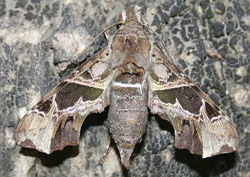
Unzela j. japix Vladimir Izersky
|
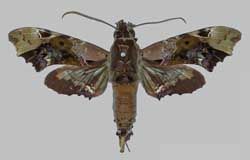
Unzela pronoe pronoe James Hogue
|
|
+++++++
Use your browser "Back" button to return to the previous page.
Visit Sphingini: Manduca
Visit Sphingini: Agrius, Amphimoea, Cocytius, Euryglottis, Lintneria, Sphinx
Visit Smerinthini: Adhemarius, Orecta and Protambulyx
You are here: Dilophonotini: Aleuron, Enyo, Pachygonidia and Unzela
Visit Dilophonotini: Aellopos, Eupyrrhoglossum, Nyceryx and Perigonia
Visit Dilophonotini: Callionima, Erinnyis, Hemeroplanes, Isognathus, Madoryx, Oryba, Pachylia, Pachylioides, Phryxus
and Pseudosphinx
Visit Philampelini: Eumorpha
Visit Macroglossini: Hyles and Xylophanes
This page is brought to you by
Bill Oehlke and the
WLSS. Pages are on space rented from Bizland. If you would like
to become a "Patron of the Sphingidae Site", contact Bill.
Please send sightings/images to Bill. I will do my best to respond to
requests for identification help.
 | 
Show appreciation for this site by clicking on flashing butterfly to the left.
The link will take you to a page with links to many insect sites. |
